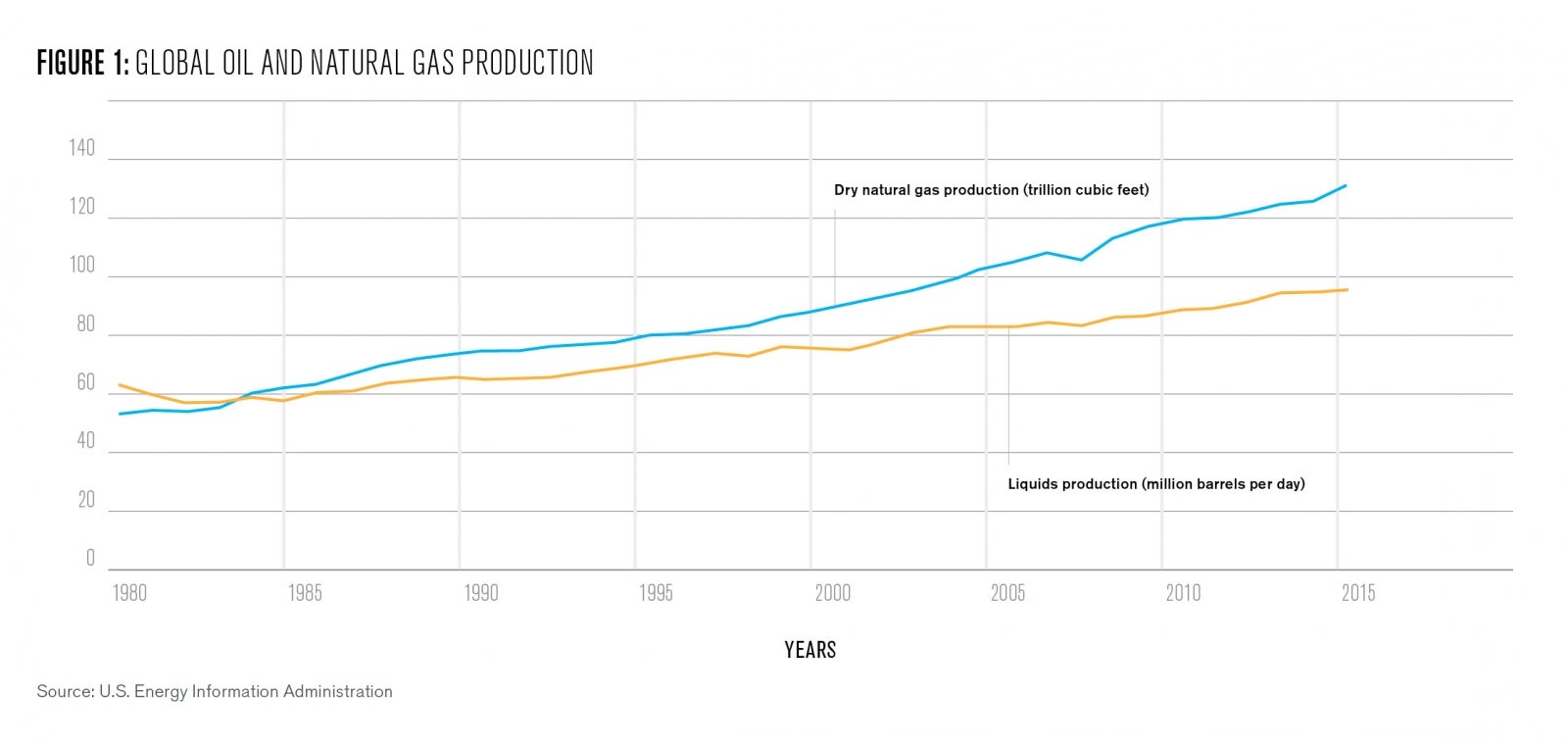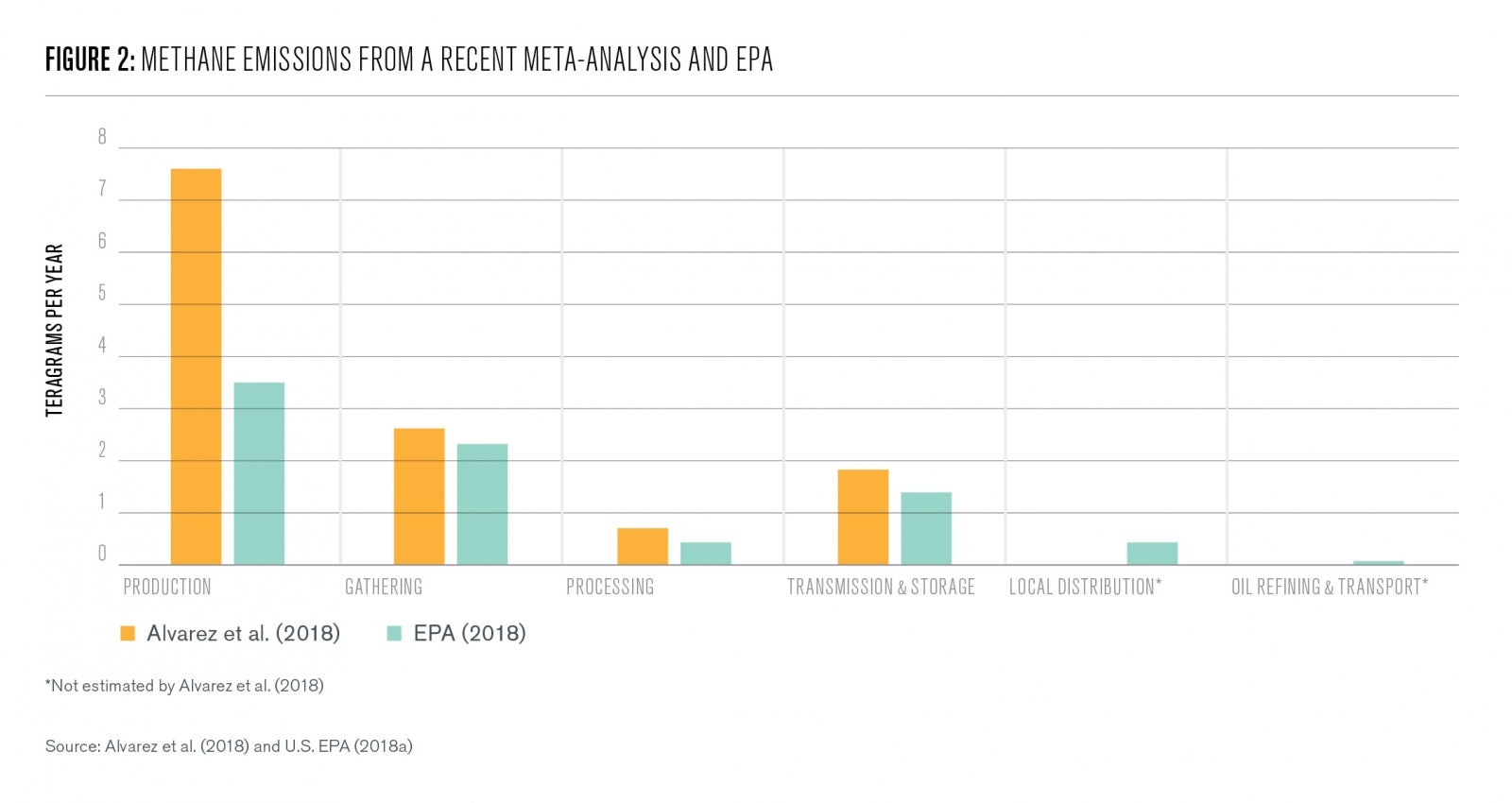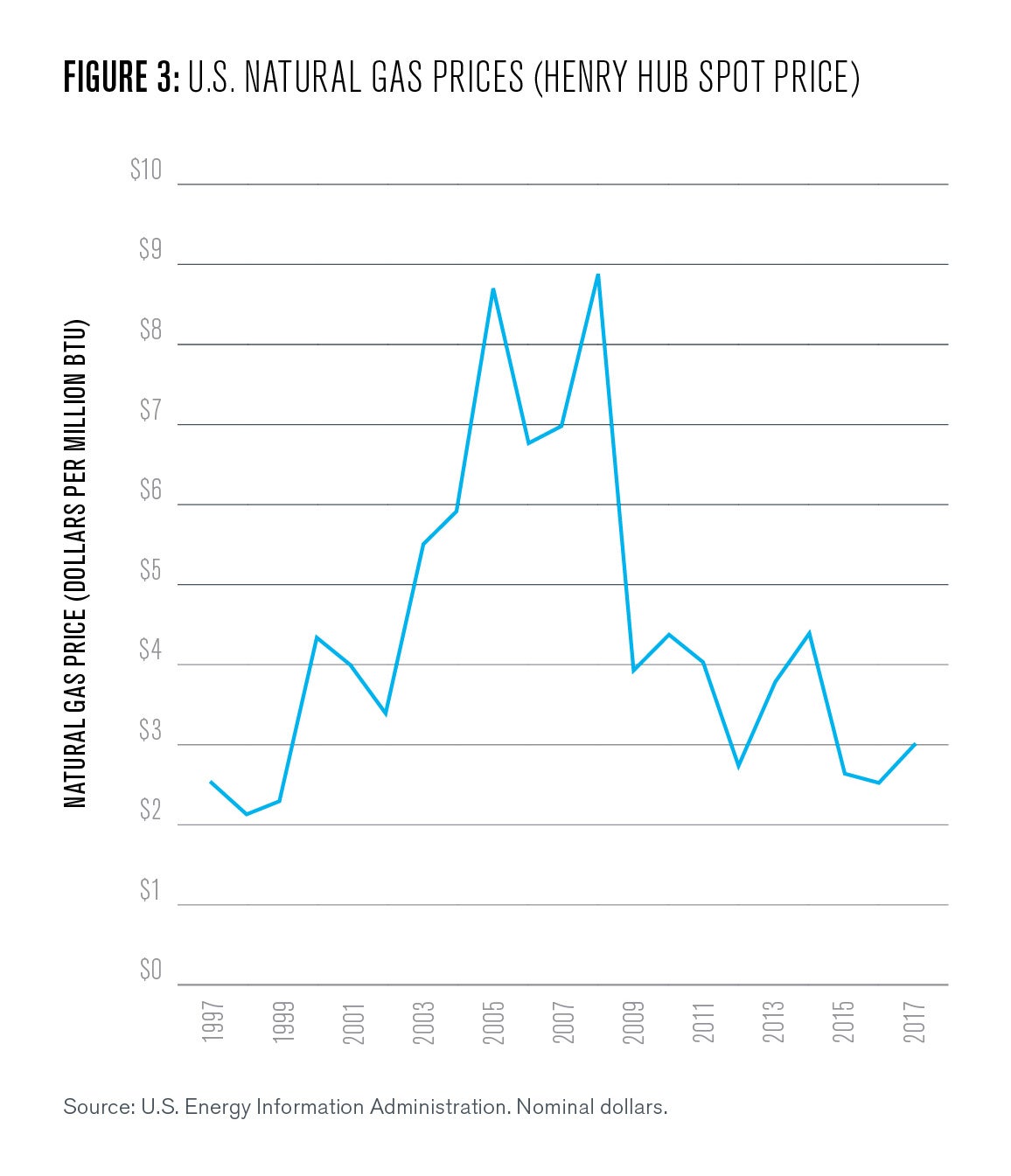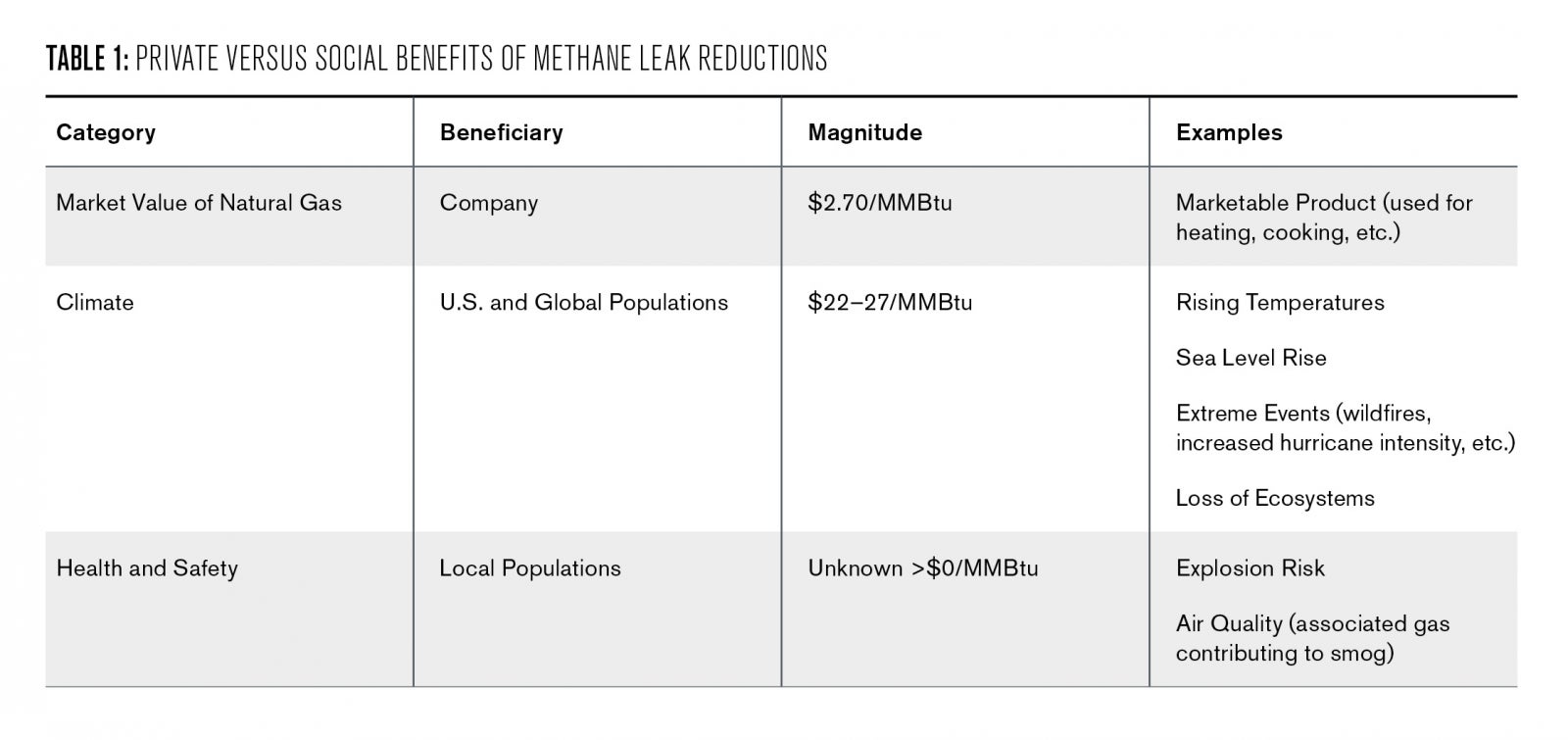Plugging the Leaks: Why Existing Financial Incentives Aren’t Enough to Reduce Methane

While multiple sectors emit methane, a major contributor is the oil and gas industry. This digest explores methane's impacts on climate change and the market forces shaping leaks and abatement.
The Problem
Methane is a significant contributor to global climate change, representing 16 to 20% of total greenhouse gas emissions, on a CO2-equivalent basis, in 2010 (Intergovernmental Panel on Climate Change 2014a). While multiple sectors emit methane, a major contributor is the production and use of fossil fuels, particularly the oil and gas industry (U.S. Environmental Protection Agency 2012). With global oil and gas production growing (Figure 1), understanding the scientific and market forces surrounding these emissions is a crucial component of climate policy.

Global estimates of oil and gas methane emissions are highly uncertain (an important issue that we will explore), but one recent study estimated that 3.6 trillion cubic feet of methane were emitted by global oil and gas systems in 2012 (Larsen, Delgado, and Marsters 2015). At current estimates of the monetary cost of climate change impacts (discussed in detail below), these emissions caused roughly $75 to $100 billion in global damages.1
Although companies would, in most cases, prefer not to waste methane, leaks are commonplace because—from a company’s perspective—they are not always cost-effective to prevent or to fix once they occur.
Scientists and environmental advocates are increasingly calling attention to the methane problem, and some jurisdictions have responded with new policy. At the U.S. federal level, the Obama administration developed initiatives through the Bureau of Land Management (BLM) and the Environmental Protection Agency (EPA); California, Colorado, Pennsylvania, Wyoming, and others have proposed state-level rules; the Global Methane Initiative is a multilateral initiative across dozens of countries; and the One Future Initiative brings together leading energy companies to reduce methane emissions. However, the Trump administration has walked back some Obama-era rules, and as of this writing, the EPA is accepting comments on a proposed rollback of its earlier regulations (U.S. Environmental Protection Agency 2018d).
In this policy brief, we summarize the best available evidence on oil- and gas-related methane emissions in the U.S. and the damages they cause. We then describe the market forces shaping methane leaks and their abatement. We conclude by drawing lessons for policy-makers.
The Science of Methane Leaks
Around one third of U.S. anthropogenic methane emissions are from the oil and gas sector (other major contributors are livestock, manure, landfills, and coal mines). The reason is simple: the primary component of natural gas is methane, and gas leaks occur throughout the supply chain. Moreover, since most oil wells also produce natural gas, extraction of oil can increase methane emissions.
Leaks can occur at all stages of the supply chain, including production, processing, long distance transmission, and local distribution. Some leaks occur when underground pipelines corrode; others occur at surface equipment; and still others occur when gas is intentionally vented during maintenance tasks. Detecting and measuring leaks is hard, since methane itself is odorless and colorless—the “rotten egg” smell most people associate with natural gas is due to an odorant added to help make it detectable.
Measuring methane emissions has been a key focus of recent research. Scholars have published dozens of studies examining emissions from specific pieces of oil and gas production equipment (e.g., Allen et al. 2013, 2015), processing equipment (e.g., C. W. Moore et al. 2014; Marchese et al. 2015; Mitchell et al. 2015), and transportation infrastructure (e.g., Phillips et al. 2013; Jackson et al. 2014; Gallagher et al. 2015), as well as collecting “top-down” measurements of methane emissions across broad regions (e.g., Karion et al. 2013, 2015; Kort et al. 2016; Barkley et al. 2017).
A recent meta-analysis of many of these studies estimated that roughly 2.3% of natural gas production in the United States is emitted as methane (Alvarez et al. 2018), about 60% higher than the most recent estimates from the U.S. Environmental Protection Agency (U.S. Environmental Protection Agency 2018a). This revised estimate is likely more accurate because it is based on a set of measurements that are both more recent and more comprehensive than the existing EPA estimates.
As Figure 2 shows, the meta-analysis found substantially higher emissions than EPA estimates: 117% higher during production, 13% higher during gathering, 64% higher during processing, and 29% higher during transmission and storage. And while the meta-analysis did not update emissions from the distribution sector nor from “behind-the-meter” uses like home furnaces or water heaters, other work suggests that the EPA’s estimates may be too low at those stages of the supply chain as well (Phillips et al. 2013; Jackson et al. 2014; Alvarez et al. 2018).

As that methane accumulates in the atmosphere, it traps heat, contributing to global warming. And although methane’s effects on the climate are not nearly as long lasting as carbon dioxide, methane—on a pound for pound basis—traps more than 80 times as much heat in the atmosphere as CO2 over a 20-year timeframe, and more than 30 times as much over 100 years (U.S. Environmental Protection Agency 2018b).
Climate-related damages from methane have been estimated at $1,300 to 1,600 per ton (U.S. Environmental Protection Agency 2018c, p. A-8). Those estimates were part of a major U.S. government initiative by policymakers and academics to quantify the risks to society from climate change (Interagency Working Group on the Social Cost of Carbon 2010, 2013, 2016). Recent peer-reviewed studies have estimated even higher damages from climate change (e.g., Pindyck 2017; F. C. Moore et al. 2017; Ricke et al. 2018), though substantial uncertainty remains.
In addition to the climate risks, methane leaks can pose a public safety hazard. While methane itself has no direct impact on human health at most concentrations, natural gas leaks frequently include other gases that are toxic and/or contribute to ground-level ozone (smog) (Carter and Seinfeld 2012; McMullin et al. 2018; Fann et al. 2018). And in rare cases, leaking natural gas can cause explosions—and indeed, fatalities have occurred because of explosions from transmission lines (Bowe and Pickoff-White 2015), distribution lines (McEvoy 2013), and gathering lines (Elliot 2017; Soraghan and Lee 2018).
The Economics of Methane Leaks
Companies that produce, process, and transport natural gas and oil often argue (e.g., Henry 2016; Silverstein 2018) that they have an economic incentive to reduce methane emissions and market the captured gas as a product.
According to economic theory, companies will capture methane emissions if the economic costs of doing so are less than the value of the lost gas. In fact, the revenue that private companies stand to gain from capturing each unit of methane has been relatively low in recent years, as increased domestic natural gas production has lowered benchmark prices (Figure 3) to an annual average of $2.70 per million British thermal units (MMBtu) for 2015-2017 (U.S. Energy Information Administration 2018).

More importantly, the company’s argument about their desire to avoid lost product is only partially correct: while there is some economic incentive to prevent leaks, it is not at the full, socially-optimal level. A simple rule of thumb from the field of economics tells us that government regulation is needed to address the methane issue. That rule is as follows: if there is an externality associated with methane emissions, then private actors will reduce emissions at a rate that is less than optimal for society as a whole.
From society’s perspective, the damage caused by each additional MMBtu of methane emissions ranges from $2.80 to $27 in addition to the value of the lost gas. This number ranges widely because there are a number of important assumptions that affect the social cost of methane.
EPA states that, using a domestic-only social cost of methane—which is preferred by the Trump Administration, and which only accounts for the impacts of global warming directly affecting the United States—and a discount rate of 3%, each metric ton of methane emissions results in $170 to $200 worth of damages to society, roughly equivalent to $2.80-3.30/MMBtu.2
However, leading economists have argued for the application of a global social cost of methane—that is, accounting for the global damages of climate change, rather than only those directly experienced in the United States—under which the damages to society from each metric ton of methane emissions are roughly $1,300 to $1,600—equivalent to $22 to $27/MMBtu (U.S. Environmental Protection Agency 2018c, p. A-8).3 Moreover, these estimates do not reflect advances in the scientific understanding of methane’s atmospheric and radiative efficacy, which are expected to increase the cost estimates for methane (U.S. Environmental Protection Agency 2018c, p. 3-12).
It’s worth noting that these global damages reflect real economic risks to the United States, as climate change will impact the global economy (Intergovernmental Panel on Climate Change 2014b; Burke, Hsiang, and Miguel 2015; Burke, Davis, and Diffenbaugh 2018), with which the U.S. economy is well-integrated. In addition, climate change poses risks for increased civil conflict (Burke et al. 2010; Hsiang, Meng, and Cane 2011), with implications for U.S. security and the economy.
Stepping back, then, it becomes clear what is missing from companies’ claims that their financial incentives are properly aligned to detect and abate leaks. Suppose a leak repair technology costs $10 per MMBtu of gas captured. A private company will not implement that technology, since it costs more than the potential revenue of the captured gas ($2.70). At the same time, society as a whole would very much like the company to implement the technology, since it avoids $22 to $27 per MMBtu of climate damages such as hurricane and wildfire risk, plus the other safety and health risks described above.

Policy Implications
This simple exercise provides a powerful lesson: government regulation to reduce methane emissions can benefit society. This is true under any market condition, since a company can only capture the private benefits of captured methane, whereas society as a whole—not just the company—bears the damages associated with climate risks. Moreover, this idea points to the weakness inherent in voluntary targets set by companies—they do not come with the financial incentive that guarantees sufficient emissions abatement.
In the presence of this externality, companies will fail to capture methane emissions when the cost is above $2.70/MMBtu, regardless of the full social value of captured emissions ($2.70/MMBtu plus $22 to $27/MMBtu of climate risks, plus additional health and safety risks). Government regulations are thus needed to induce methane capture, and recent studies show that there are many opportunities for low-cost abatement (ICF International 2014). Those regulations should be designed to capture the “low hanging fruit,” achieving the greatest possible reductions for the lowest possible costs.
A challenge going forward is that we do not yet have comprehensive methane monitoring, implying that some regulatory options (such as an emissions tax that includes methane leaks) are not currently feasible.
One option, a flat tax on production, processing, and transport would not be equivalent—it would equally punish gas sold and gas leaked, which would not properly incentivize leak capture. At the same time, more extreme policy measures, such as fracking bans, would imply that a valuable product would not be available to consumers. Our own research suggests that the climate damages are not currently large enough to justify a ban on fracking (Hausman and Kellogg 2015; Raimi 2017). In fact, under some conditions, the increased use of natural gas can help reduce greenhouse gas emissions in the short term, by allowing for a more rapid transition away from coal (Newell and Raimi 2014; Raimi 2017).
The options left on the table, then, are regulations on the way that natural gas and oil are extracted, processed and transported. That is exactly what the Obama administration’s rules were intended to target—rules that the Trump administration would like to roll back.
Additional regulatory options may be appropriate at the distribution stage. For example, many distribution companies are price-regulated by state utility commissions. Under this structure, the companies are typically reimbursed for the value of their leaked gas, reducing or eliminating their financial incentive to plug leaks. California has taken steps forward in this domain (California Public Utilities Commission 2018), and other policy options are briefly described in Hausman and Muehlenbachs (2018) and Costello (2013).
Moreover, new technologies are emerging that will allow companies throughout the supply chain to more easily identify so-called “super-emitters,” the small number of sites that account for a large proportion of emissions (Brandt, Heath, and Cooley 2016; Mayfield, Robinson, and Cohon 2017). These technologies may continue to improve over time, allowing for lower-cost abatement opportunities moving forward. Regulations could take advantage of, and perhaps even incentivize, these and other emerging leak detection and repair technologies.
In short, market forces will not solve the problem of methane leaks. While companies have an incentive to capture the escaping gas, that incentive is well below the levels which would be best for society as a whole. As technologies for detecting and measuring methane emissions become cheaper, the private incentive to capture more methane may increase. But Economics 101 tells us that in the presence of an externality like this one, there is a clear justification for government action.
Affiliations are provided for identification purposes. These views represent those of Hausman and Raimi, not the University of Michigan nor Resources for the Future.
The author wishes to acknowledge the helpful comments of Dr. James R. Hines. Any remaining errors are the responsibility of the author alone.
Catherine Hausman
Assistant Professor, University of MichiganCatherine Hausman is an assistant professor in the School of Public Policy at the University of Michigan. Hausman was a 2018-2019 Kleinman Center visiting scholar.
Daniel Raimi
Research Associate, Resources for the FutureDaniel Raimi is a senior research associate at Resources for the Future, where he focuses on energy and climate policy. He teaches energy policy at the Gerald R. Ford School of Public Policy at the University of Michigan, and is a faculty affiliate at the University of Michigan Energy Institute.
Allen, David T., David W. Sullivan, Daniel Zavala-Araiza, Adam P. Pacsi, Matthew Harrison, Kindal Keen, Matthew P. Fraser, et al. 2015. “Methane Emissions from Process Equipment at Natural Gas Production Sites in the United States: Liquid Unloadings.” Environmental Science & Technology 49 (1): 641–48. https://doi.org/10.1021/es504016r.
Allen, David T., Vincent M. Torres, James Thomas, David W. Sullivan, Matthew Harrison, Al Hendler, Scott C. Herndon, et al. 2013. “Measurements of Methane Emissions at Natural Gas Production Sites in the United States.” Proceedings of the National Academy of Sciences 110 (44): 17768–73. https://doi.org/10.1073/pnas.1304880110.
Alvarez, Ramón A., Daniel Zavala-Araiza, David R. Lyon, David T. Allen, Zachary R. Barkley, Adam R. Brandt, Kenneth J. Davis, et al. 2018. “Assessment of Methane Emissions from the U.S. Oil and Gas Supply Chain.” Science, June. https://doi.org/10.1126/science.aar7204.
Barkley, Zachary R., Thomas Lauvaux, Kenneth J. Davis, Aijun Deng, Natasha L. Miles, Scott J. Richardson, Yanni Cao, et al. 2017. “Quantifying Methane Emissions from Natural Gas Production in North-Eastern Pennsylvania.” Atmospheric Chemistry and Physics 17 (22): 13941–66. https://doi.org/10.5194/acp-17-13941-2017.
Bowe, Rebecca, and Rebecca Pickoff-White. 2015. “Five Years After Deadly San Bruno Explosion: Are We Safer?” KQED News, November 8, 2015. https://www.kqed.org/news/10667274/five-years-after-deadly-san-bruno-explosion-are-we-safer.
Brandt, A. R., G. A. Heath, E. A. Kort, F. O’Sullivan, G. Pétron, S. M. Jordaan, P. Tans, et al. 2014. “Methane Leaks from North American Natural Gas Systems.” Science 343 (6172): 733–35. https://doi.org/10.1126/science.1247045.
Brandt, Adam R., Garvin A. Heath, and Daniel Cooley. 2016. “Methane Leaks from Natural Gas Systems Follow Extreme Distributions.” Environmental Science & Technology 50 (22): 12512–20. https://doi.org/10.1021/acs.est.6b04303.
Burke, Marshall, W. Matthew Davis, and Noah S. Diffenbaugh. 2018. “Large Potential Reduction in Economic Damages under UN Mitigation Targets.” Nature 557 (7706): 549–53. https://doi.org/10.1038/s41586-018-0071-9.
Burke, Marshall, Solomon M. Hsiang, and Edward Miguel. 2015. “Global Non-Linear Effect of Temperature on Economic Production.” Nature 527 (7577): 235–39. https://doi.org/10.1038/nature15725.
Burke, Marshall, Edward Miguel, Shanker Satyanath, John A. Dykema, and David B. Lobell. 2010. “Climate Robustly Linked to African Civil War.” Proceedings of the National Academy of Sciences 107 (51): E185–E185. https://doi.org/10.1073/pnas.1014879107.
California Public Utilities Commission. 2018. “Methane Leak Proceeding (R. 15-01-008).” Gas Leak Abatement OIR (R. 15-01-008). http://www.cpuc.ca.gov/General.aspx?id=8829.
Carter, William P. L., and John H. Seinfeld. 2012. “Winter Ozone Formation and VOC Incremental Reactivities in the Upper Green River Basin of Wyoming.” Atmospheric Environment 50 (April): 255–66. https://doi.org/10.1016/j.atmosenv.2011.12.025.
Costello, Ken. 2013. “Lost and Unaccounted-for Gas: Practices of State Utility Commissions.” 13–06. Silver Spring, MD: National Regulatory Research Institute. http://nrri.org/download/nrri-13-06-lost-and-unaccounted-for-gas/.
Elliot, Dan. 2017. “Oil, Gas Lines near Colorado Buildings Mapped after Firestone Explosion.” The Denver Post (blog). July 1, 2017. http://www.denverpost.com/2017/06/30/firestone-explosion-oil-gas-lines-map/.
Fann, Neal, Kirk R. Baker, Elizabeth A. W. Chan, Alison Eyth, Alexander Macpherson, Elizabeth Miller, and Jennifer Snyder. 2018. “Assessing Human Health PM2.5 and Ozone Impacts from U.S. Oil and Natural Gas Sector Emissions in 2025.” Environmental Science & Technology, July. https://doi.org/10.1021/acs.est.8b02050.
Gallagher, Morgan E., Adrian Down, Robert C. Ackley, Kaiguang Zhao, Nathan Phillips, and Robert B. Jackson. 2015. “Natural Gas Pipeline Replacement Programs Reduce Methane Leaks and Improve Consumer Safety.” Environmental Science & Technology Letters 2 (10): 286–91. https://doi.org/10.1021/acs.estlett.5b00213.
Greenstone, Michael. 2017. “Statement of Michael Greenstone.” United States House Committee on Science, Space and Technology, Subcommittee on Environment, Subcommittee on Oversight, hearing on “At What Cost? Examining the Social Cost of Carbon.” https://science.house.gov/sites/republicans.science.house.gov/files/documents/HHRG-115-SY18-WState-MGreenstone-20170228.pdf.
Hausman, Catherine, and Ryan Kellogg. 2015. “Welfare and Distributional Implications of Shale Gas.” Brookings Papers on Economic Activity. Washington, D.C.: Brookings Institution. https://www.brookings.edu/wp-content/uploads/2015/03/2015a_hausman.pdf.
Hausman, Catherine, and Lucija Muehlenbachs. 2018. “Price Regulation and Environmental Externalities: Evidence from Methane Leaks.” Journal of the Association of Environmental and Resource Economists 6 (1): 73–109. https://doi.org/10.1086/700301.
Henry, Devin. 2016. “Thirteen States Sue over EPA Methane Rule.” Text. TheHill. August 2, 2016. https://thehill.com/policy/energy-environment/290159-thirteen-states-sue-over-epa-methane-rule.
Hsiang, Solomon M., Kyle C. Meng, and Mark A. Cane. 2011. “Civil Conflicts Are Associated with the Global Climate.” Nature 476 (7361): 438–41. https://doi.org/10.1038/nature10311.
ICF International. 2014. “Economic Analysis of Methane Emission Reduction Opportunities in the U.S. Onshore Oil and Natural Gas Industries.” https://www.edf.org/sites/default/files/methane_cost_curve_report.pdf.
Interagency Working Group on the Social Cost of Carbon. 2010. “Technical Support Document: Social Cost of Carbon for Regulatory Impact Analysis Under Executive Order 12866.” https://www.epa.gov/sites/production/files/2016-12/documents/scc_tsd_2010.pdf.
———. 2013. “Technical Support Document: Technical Update of the Social Cost of Carbon for Regulatory Impact Analysis Under Executive Order 12866.” https://www.federalregister.gov/documents/2013/11/26/2013-28242/technical-support-document-technical-update-of-the-social-cost-of-carbon-for-regulatory-impact.
———. 2016. “Addendum to Technical Support Document on Social Cost of Carbon for Regulatory Impact Analysis under Executive Order 12866: Application of the Methodology to Estimate the Social Cost of Methane and the Social Cost of Nitrous Oxide.” United States. Environmental Protection Agency. Science Advisory Board. https://www.epa.gov/sites/production/files/2016-12/documents/addendum_to_sc-ghg_tsd_august_2016.pdf.
Intergovernmental Panel on Climate Change. 2014a. “Climate Change 2013 – The Physical Science Basis: Working Group I Contribution to the Fifth Assessment Report of the Intergovernmental Panel on Climate Change.” Cambridge: Cambridge University Press. https://doi.org/10.1017/CBO9781107415324.
———. 2014b. “Climate Change 2014: Impacts, Adaptation, and Vulnerability. Part A: Global and Sectoral Aspects. Contribution of Working Group II to the Fifth Assessment Report of the Intergovernmental Panel on Climate Change.” Cambridge, UK and New York, NY: Cambridge University Press. http://www.ipcc.ch/report/ar5/wg2/.
Jackson, Robert B., Adrian Down, Nathan G. Phillips, Robert C. Ackley, Charles W. Cook, Desiree L. Plata, and Kaiguang Zhao. 2014. “Natural Gas Pipeline Leaks Across Washington, DC.” Environmental Science & Technology 48 (3): 2051–58. https://doi.org/10.1021/es404474x.
Karion, Anna, Colm Sweeney, Eric A. Kort, Paul B. Shepson, Alan Brewer, Maria Cambaliza, Stephen A. Conley, et al. 2015. “Aircraft-Based Estimate of Total Methane Emissions from the Barnett Shale Region.” Environmental Science & Technology 49 (13): 8124–31. https://doi.org/10.1021/acs.est.5b00217.
Karion, Anna, Colm Sweeney, Gabrielle Pétron, Gregory Frost, R. Michael Hardesty, Jonathan Kofler, Ben R. Miller, et al. 2013. “Methane Emissions Estimate from Airborne Measurements over a Western United States Natural Gas Field.” Geophysical Research Letters 40 (16): 4393–97. https://doi.org/10.1002/grl.50811.
Kort, E. A., M. L. Smith, L. T. Murray, A. Gvakharia, A. R. Brandt, J. Peischl, T. B. Ryerson, C. Sweeney, and K. Travis. 2016. “Fugitive Emissions from the Bakken Shale Illustrate Role of Shale Production in Global Ethane Shift: Ethane Emissions From the Bakken Shale.” Geophysical Research Letters 43 (9): 4617–23. https://doi.org/10.1002/2016GL068703.
Larsen, Kate, Michael Delgado, and Peter Marsters. 2015. “Untapped Potential: Reducing Global Methane Emissions from Oil and Natural Gas Systems.” Rhodium Group. https://www.edf.org/sites/default/files/content/rhg_untappedpotential_april2015.pdf.
Marchese, Anthony J., Timothy L. Vaughn, Daniel J. Zimmerle, David M. Martinez, Laurie L. Williams, Allen L. Robinson, Austin L. Mitchell, et al. 2015. “Methane Emissions from United States Natural Gas Gathering and Processing.” Environmental Science & Technology 49 (17): 10718–27. https://doi.org/10.1021/acs.est.5b02275.
Mayfield, Erin N., Allen L. Robinson, and Jared L. Cohon. 2017. “System-Wide and Superemitter Policy Options for the Abatement of Methane Emissions from the U.S. Natural Gas System.” Environmental Science & Technology 51 (9): 4772–80. https://doi.org/10.1021/acs.est.6b05052.
McEvoy, Colin. 2013. “UGI Agrees to Pay $500,000 Fine for Fatal Allentown Gas Explosion.” LehighValleyLive.Com, February 25, 2013. https://www.lehighvalleylive.com/allentown/index.ssf/2013/02/ugi_agrees_to_pay_500000_fine.html.
McMullin, Tami, Alison Bamber, Daniel Bon, Daniel Vigil, Michael Van Dyke, Tami S. McMullin, Alison M. Bamber, Daniel Bon, Daniel I. Vigil, and Michael Van Dyke. 2018. “Exposures and Health Risks from Volatile Organic Compounds in Communities Located near Oil and Gas Exploration and Production Activities in Colorado (U.S.A.).” International Journal of Environmental Research and Public Health 15 (7): 1500. https://doi.org/10.3390/ijerph15071500.
Mitchell, Austin L., Daniel S. Tkacik, Joseph R. Roscioli, Scott C. Herndon, Tara I. Yacovitch, David M. Martinez, Timothy L. Vaughn, et al. 2015. “Measurements of Methane Emissions from Natural Gas Gathering Facilities and Processing Plants: Measurement Results.” Environmental Science & Technology 49 (March): 3219–27. https://doi.org/10.1021/es5052809.
Moore, Christopher W., Barbara Zielinska, Gabrielle Pétron, and Robert B. Jackson. 2014. “Air Impacts of Increased Natural Gas Acquisition, Processing, and Use: A Critical Review.” Environmental Science & Technology 48 (15): 8349–59. https://doi.org/10.1021/es4053472.
Moore, Frances C., Uris Baldos, Thomas Hertel, and Delavane Diaz. 2017. “New Science of Climate Change Impacts on Agriculture Implies Higher Social Cost of Carbon.” Nature Communications 8 (1): 1607. https://doi.org/10.1038/s41467-017-01792-x.
Newell, Richard G., and Daniel Raimi. 2014. “Implications of Shale Gas Development for Climate Change.” Environmental Science & Technology 48 (15): 8360–68. https://doi.org/10.1021/es4046154.
Phillips, Nathan G., Robert Ackley, Eric R. Crosson, Adrian Down, Lucy R. Hutyra, Max Brondfield, Jonathan D. Karr, Kaiguang Zhao, and Robert B. Jackson. 2013. “Mapping Urban Pipeline Leaks: Methane Leaks across Boston.” Environmental Pollution 173 (February): 1–4. https://doi.org/10.1016/j.envpol.2012.11.003.
Pindyck, Robert S. 2017. “Coase Lecture—Taxes, Targets and the Social Cost of Carbon.” Economica 84 (335): 345–64. https://doi.org/10.1111/ecca.12243.
Raimi, Daniel. 2017. The Fracking Debate. New York: Columbia University Press.
Ricke, Katharine, Laurent Drouet, Ken Caldeira, and Massimo Tavoni. 2018. “Country-Level Social Cost of Carbon.” Nature Climate Change, September, 1. https://doi.org/10.1038/s41558-018-0282-y.
Silverstein, Ken. 2018. “Methane Leaks Are Burning Oil And Natural Gas Producers — But They Are Not Sitting Still.” Forbes. April 16, 2018. https://www.forbes.com/sites/kensilverstein/2018/04/16/methane-leaks-are-burning-oil-and-natural-gas-producers-but-they-are-not-sitting-still/.
Soraghan, Mike, and Mike Lee. 2018. “Pipeline in Fatal Blast Had a Dime-Sized Hold in It.” EnergyWire, E&E News. September 10, 2018. https://www.eenews.net/stories/1060096333.
U.S. Energy Information Administration. 2018. “Natural Gas Spot and Futures Prices (NYMEX).” Washington, D.C. https://www.eia.gov/dnav/ng/ng_pri_fut_s1_m.htm.
U.S. Environmental Protection Agency. 2012. “Summary Report: Global Anthropogenic Non-CO2 Greenhouse Gas Emissions: 1990 – 2030.” EPA 430-S-12-002. Washington, D.C. https://www.epa.gov/sites/production/files/2016-05/documents/summary_global_nonco2_projections_dec2012.pdf.
———. 2018a. “Inventory of U.S. Greenhouse Gas Emissions and Sinks: 1990-2016.” https://www.epa.gov/ghgemissions/inventory-us-greenhouse-gas-emissions-and-sinks.
———. 2018b. “Understanding Global Warming Potentials.” Washingto, D.C. https://www.epa.gov/ghgemissions/understanding-global-warming-potentials.
———. 2018c. “Regulatory Impact Analysis for the Proposed Reconsideration of the Oil and Natural Gas Sector Emission Standards for New, Reconstructed, and Modified Sources.” EPA-452/R-18-001. Washington, D.C. https://www.epa.gov/sites/production/files/2018-09/documents/oil_and_natural_gas_nsps_reconsideration_proposal_ria.pdf.
———. 2018d. “Oil and Natural Gas Sector: Emission Standards for New, Reconstructed, and Modified Sources Reconsideration.” Federal Register Notice 83 FR 52056. Proposed Rule. Washington, D.C. https://www.federalregister.gov/documents/2018/10/15/2018-20961/oil-and-natural-gas-sector-emission-standards-for-new-reconstructed-and-modified-sources.
- This calculation uses the social cost of methane of $1,300 to $1,600 per metric ton (U.S. Environmental Protection Agency 2018c, p. A-8); and the conversion between tons of CH4 and cubic feet of natural gas in Brandt et al. (2014). [↩]
- Page 3 to 9 of the EPA’s Regulatory Impact Assessment (RIA) for the Proposed Reconsideration of the Oil and Natural Gas Sector Emission Standards for New, Reconstructed, and Modified Sources (U.S. Environmental Protection Agency 2018b). For this conversion from metric tons of methane to MMBtu, we use the conversion factors in Brandt et al. (2014) and the conversion of 1 MMBtu per 1.028 Mcf from EPA (U.S. Environmental Protection Agency 2018c). [↩]
- A global social cost of greenhouse gases and a discount rate of 3% are consistent with methods and models used by federal agencies, in line with the best available peer-reviewed scientific and economic studies, and upheld by the courts, as testified by Michael Greenstone to the United States House Committee on Science, Space and Technology, February 28, 2017 (Greenstone 2017). [↩]


